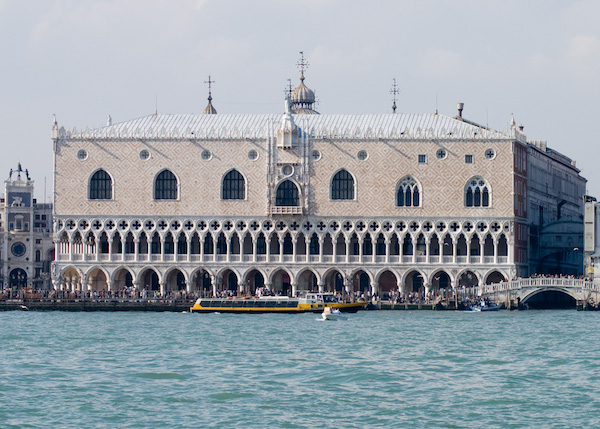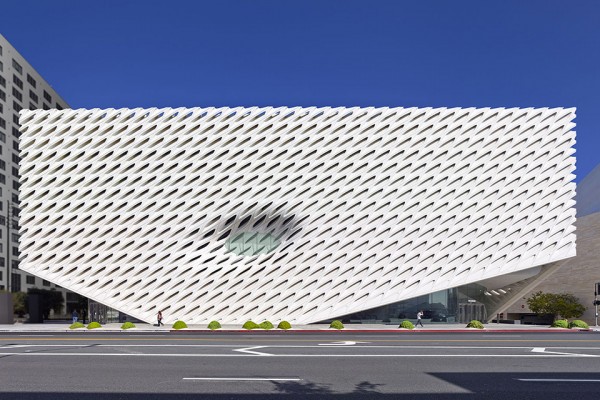The Broad is an experience. A social experience. People discovering art, discovering other people. Moving around in all directions looking at art, shooting selfies with artworks as their background. There is no linear itinerary, no sequence to follow. Visitors interact with creations as they choose.
[embedvideo id=”154667205″ website=”vimeo”]
The public is attracted from the street by the box’s sliced corner of the main entrance, which exposes a glass wall behind the porous skin. The lobby, which lacks ticket boxes since access is free, captures people’s attention with a cave-like ceiling that is penetrated by a 105-foot-long escalator. This oblique bridge pulls the public directly from the lobby to the third floor, bypassing the second floor’s vault, which contains the bulk of 2,000 artworks.
Art museums have become the pantheistic cathedrals of the Western world. No major city lacks a number of them. They celebrate self-expression by thousands of artists through self-expression by hundreds of architects. Partners Elisabeth Diller, Ricardo Scofidio and Charles Renfro of New York, the architects (of New York’s successful High Line) follow this trend.
Although The Broad is self-contained, in total contrast with Gehry’s Disney Hall’s dissonant Baroque, the building’s punctured boxy shape seems a three-dimensional logo or app that can be identified in seconds. This fabricated volume is called by the architects “the vault and the veil.” Only the “oculus,” an elliptic concave window facing Grand Avenue, accents the ornamental façade, reminiscent of Venice’s Doge Palace central balcony.

The veil frames people and artworks in an area 210 x 210 feet free of columns. The central space functions like an introverted piazza, where light is brought in uniformly, harvested by 318 north-facing skylights. At its center, a transparent elevator, the escalator and the stairs provide a clear point of reference. From there the visitor moves towards compartmentalized areas organized by periods or artists, which can be reshaped by a curator as may be needed.
Philanthropists Edythe and Eli Broad started to collect art in the 1960’s. Beginning with impressionist paintings, they switched their interests to New York-based Pop art. In the 1980’s they started to collect works by Los Angeles-based artists, and also important German artists’ works. The whole collection includes works by Lichtenstein, Koons, Baldessari, Cindy Sherman, Basquiat, Rauschenberg, Barbara Kruger, Ed Ruscha, Frank Stella, Andy Warhol, Cy Twombly and Bill Viola, among other two-hundred artists.
The building sits on one acre of land and totals 120,000 square feet. Built in five years at a cost of $140 million, its galleries total 50,000 square feet, 35,000 on the third floor and 15,000 on the first. The vault has an area of 21,000 square-feet. The second floor concrete slab cantilevers 45-feet over the lobby, while the roof has a 40-foot cantilever over the third-floor gallery.
The whole building stands over a three-story subterranean parking garage with 344 parking spaces. The elevators from the parking floors, rather than bringing the visitor directly into the lobby, open into a plaza animated by 100-year-old Barouni olive trees, where people can take a casual break to eat on the grass or read a book.
Bunker Hill’s Grand Avenue, already marked by significant architecture, has now a new urban presence. Within a few blocks, it is accompanied by high-caliber siblings such as the Cathedral of Our Lady of the Angels, the Ahmanson Theater, the Dorothy Chandler Pavilion, the Grand Park, the Walt Disney Concert Hall, the Colburn School, MOCA and the Grand Arts High School. The spiritual aspect of the Broad’s rational architecture is in the way it frames the spectator’s dialogue with the artists’ demons under a bath of light.
Rick Meghiddo is an architect and a filmmaker. As an architect, he focuses on innovative work that is sustainable, aesthetic, and budget-conscious, looking at each project as an opportunity to rethink solutions to conventional problems. As a filmmaker, he brings his "architect eye" to help non-professionals and professionals better understand the meaning, value, and complexities of architecture and art.
Born in Argentina, he studied architecture at the University of Buenos Aires, at the Technion in Israel, and earned his M. Arch from UCLA and his Dottore in Architettura from the University of Rome. Following over three decades of practice as an architect in Los Angeles, Tel Aviv, and Rome, he produced and directed over one hundred documentaries, mostly on architecture and art.
Rick is also a registered journalist with USPA and a published poet. He is fluent in English, Spanish, Italian, Hebrew, and oral French. Selected works in architecture, photography, art, and poetry can be seen in http://meghiddoarchitects.com/ His documentaries can be seen in http://archidocu.com/ and in http://architectureawareness.com/
Born in Argentina, he studied architecture at the University of Buenos Aires, at the Technion in Israel, and earned his M. Arch from UCLA and his Dottore in Architettura from the University of Rome. Following over three decades of practice as an architect in Los Angeles, Tel Aviv, and Rome, he produced and directed over one hundred documentaries, mostly on architecture and art.
Rick is also a registered journalist with USPA and a published poet. He is fluent in English, Spanish, Italian, Hebrew, and oral French. Selected works in architecture, photography, art, and poetry can be seen in http://meghiddoarchitects.com/ His documentaries can be seen in http://archidocu.com/ and in http://architectureawareness.com/
